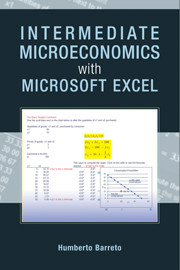Book contents
- Frontmatter
- Contents
- Preface
- User Guide
- Introduction
- PART I THE THEORY OF CONSUMER BEHAVIOR
- PART II THE THEORY OF THE FIRM
- 2.1 Production Function
- 2.2 Input Cost Minimization
- 2.3 Output Profit Maximization
- 2.4 Input Profit Maximization
- 2.5 Consistency in the Theory of the Firm
- 2.6 Monopoly
- 2.7 Game Theory
- PART III THE MARKET SYSTEM
- Conclusion
- Index
2.5 - Consistency in the Theory of the Firm
from PART II - THE THEORY OF THE FIRM
Published online by Cambridge University Press: 05 June 2012
- Frontmatter
- Contents
- Preface
- User Guide
- Introduction
- PART I THE THEORY OF CONSUMER BEHAVIOR
- PART II THE THEORY OF THE FIRM
- 2.1 Production Function
- 2.2 Input Cost Minimization
- 2.3 Output Profit Maximization
- 2.4 Input Profit Maximization
- 2.5 Consistency in the Theory of the Firm
- 2.6 Monopoly
- 2.7 Game Theory
- PART III THE MARKET SYSTEM
- Conclusion
- Index
Summary
[That long-run responses are more elastic than short run responses] is commonly believed to be empirically true, simply as a matter of assertion. It is interesting and noteworthy that this type of behavior is in fact mathematically implied by a maximization hypothesis.
Eugene SilberbergWe have considered three separate optimization problems in our study of the perfectly competitive firm.
Figures 2.5.1.1, 2.5.1.2, and 2.5.1.3 provide a snapshot of the initial solution and the key comparative statics analysis from each of the three optimization problems.
Key Idea
These three problems are tightly integrated and are actually different views of the same firm and same optimal solution. Change an exogenous variable and all three optimization problems are affected. The new optimal solutions and comparative statics results are consistent – i.e., they tell you the same thing and are never contradictory.
The idea of consistency in the Theory of the Firm can be demonstrated by example.
Perfect Competition in the Long Run
Step Open the Excel workbook Consistency.xls and read the Intro sheet; then proceed to the TheoryoftheFirmLongRun sheet. Use the Zoom In button to fill your screen with graphs.
Figure 2.5.1.4 displays what is on your screen.
Gray-backgrounded cells are dead (click on one to see that it has a number, not a formula) – they will serve as benchmarks for comparisons when we do comparative statics.
- Type
- Chapter
- Information
- Intermediate Microeconomics with Microsoft Excel , pp. 377 - 388Publisher: Cambridge University PressPrint publication year: 2009



